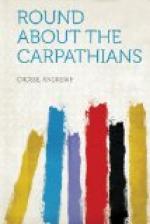When we reached Orsova we only stopped long enough to get some dinner and take the usual siesta. This place is on the frontier; three miles farther down you pass out of Hungary into Roumanian territory. Had we stayed any time we should certainly have gone to see Trajan’s bridge, about eighteen miles hence. The so-called “Iron Gates” are just below Orsova. The designation is a misnomer, for the river ceases to be pent up between a defile, the hills recede from the shore, and the “Gates” are merely ledges of rock peculiarly difficult for navigation. Orsova is celebrated as the place where the regalia of Hungary were concealed by Kossuth and his friends from 1849 to 1853. The iron chest which held the palladium of the kingdom, the sacred crown of St Stephen, was buried in a waste spot, covered with willows, not far from the road. There is a somewhat Oriental look about Orsova. In the market-place there is a profusion of bright-coloured stuffs, prayer-carpets, and Turkish slippers. A narrow island of no great length, just below Orsova, is still held by the Turks. There is a small mosque with minarets visible amongst a group of the funeral cypress-tree, so characteristic of the presence of the Turk.
Our road to Mehadia was away from the river, following instead the lead of a lateral valley. As we drove out of Orsova we passed a lot of Wallack huts forming a kind of suburb. These huts are built of wattles stuccoed with mud, always having on one side of the dwelling a space enclosed by stockades some ten feet high; this is a necessary protection for their animals against the depredations of wolves and bears, which abound here.
Leaving this village we continued our way through the Cserna Valley, which has few signs of cultivation beyond the orchards and vineyards that climb up the hillsides of the narrow ravine. On our left we passed a ruined aqueduct of Turkish origin, eleven arches still remaining. As we proceeded, the valley narrowed considerably, and the scenery became more wild and striking. Here vegetation is in its richest profusion; the parasitical plants are surpassingly graceful, wreathing themselves over rocks and trees.
Mehadia, or more strictly, Hercules-Bad, is the most fashionable bath in Hungary. The village of Mehedia must not be confounded with it, for it lies at a distance of six miles thence. The situation of Hercules-Bad is extremely romantic. Above the narrow rocky valley rise bare limestone peaks, girdled with rich forests of every variety of foliage. There are two kinds of springs, the sulphurous and the saline. The Hercules source bursts out from a cleft of the rock in such an immense volume that it is said to yield 5000 cubic feet in an hour. The water has to be cooled before it is used, the natural heat being as much as 131 deg. Fahrenheit. Its efficacy is said to be so great that the patient while in the bath “feels the evil being boiled out of him”! Some of the visitors had not yet had their turn of cooking, I suppose, or if they had been boiled, were rather underdone, for I met a good many gouty and rheumatic patients still in the hobbling condition.




